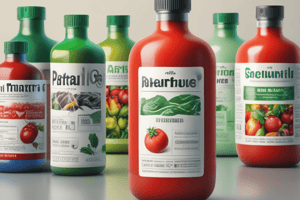Podcast
Questions and Answers
What is the definition of pesticides?
What is the definition of pesticides?
Substances used to kill or control pests.
Which of the following is an example of an acaricide?
Which of the following is an example of an acaricide?
- Azadirachtin
- Copper hydroxide
- DDT (correct)
- Chlordimeforn
What type of substance are herbicides?
What type of substance are herbicides?
- Used to kill plants (mostly weeds) (correct)
- Used to kill mites and ticks
- Used to kill fungi
- Used to kill bacteria
What do bactericides do?
What do bactericides do?
Which of the following is a type of insecticide?
Which of the following is a type of insecticide?
Fungicides can be used to inhibit bacteria in plants.
Fungicides can be used to inhibit bacteria in plants.
The chemicals used to kill plants are called ______.
The chemicals used to kill plants are called ______.
What is the role of chemosterillants?
What is the role of chemosterillants?
Which group of pesticides is produced artificially by chemical synthesis?
Which group of pesticides is produced artificially by chemical synthesis?
Name one example of a neonicotinoid insecticide.
Name one example of a neonicotinoid insecticide.
What is a common function of insect growth regulators (IGRs)?
What is a common function of insect growth regulators (IGRs)?
Flashcards are hidden until you start studying
Study Notes
Definition of Pesticides
- Use or target pests are what determines which pesticide is used.
- Pesticides are classified based on their mode of action.
- Toxicity is a major factor influencing what pesticide can and cannot be used.
- Pesticides have distinct chemical structures and compositions that differentiate them from one another.
Classification of Pesticides
- Acaricides are used to kill mites and ticks. Examples include DDT, dicofol, and Fenpyroximate.
- Antifeedants prevent pests from feeding. Examples include Chlordimeforn, Fentin and Azadirachtin.
- Bactericides kill or inhibit bacteria in plants or soil. Examples include Copper hydroxide, Kasugamycin, Streptomycin, and Tetracycline.
- Fungicides prevent, inhibit, or eradicate fungi. Examples include carbendazim, thiabendazole, and thiophanate-methyl.
- Chemosterilants sterilize insects, rendering them unable to reproduce. Examples include Aziridinyl and Diflubenzuron.
- Herbicides kill or inhibit the growth of plants, particularly weeds. Examples include Paraquat, Glyphosate, and 2,4-D.
- Insecticides kill or inhibit the growth of insects. Examples include Monocrotophos, Carbofuran, and Lambdacyhalothrin.
- Nematicides are used to control nematodes. Examples include Abamectin.
- Rodenticides are used to kill rats and related animals. Examples include Zinc Phosphide and Bromadiolane.
Modes of Action
- Contact Pesticides are applied directly to the target pest, killing it on contact.
- Stomach Pesticides are ingested by the pest, killing it from the inside.
- Systemic Pesticides are absorbed by the plant and move throughout its system, killing pests that feed on it.
- Translaminar Pesticides move through the plant's outer layer and tissues, protecting against insect pests.
- Fumigant Pesticides are vaporized and applied to a space or sealed area, killing pests through inhalation.
Toxicity
- Toxicity is a factor that influences what pesticide can and cannot be used.
Chemical Structures
- Pesticides are classified by their chemical structures as well as mode of action.
Insecticides
- Natural Organic Insecticides are derived from natural sources, such as plants or microorganisms. They are divided into categories like Microbial bio-pesticides and Botanical Pesticides.
- Microbial bio-pesticides are derived from bacteria, fungi, and viruses, used to control pests. Examples include Antagonistic and Entomotoxic Bacteria, Antagonistic and Entomopathogenic Fungi, Nuclear polyhydral virus, and Baculovirus.
- Botanical Pesticides are derived from plants. Two major examples are Azadirachtin and Pyrethrin.
- Synthetic Organic Insecticides are produced artificially through chemical synthesis. These are subdivided into many categories including Organochlorine Pesticides, Organophosphate Pesticides, Carbamates, Synthetic-pyrethroid, and Other Insecticides.
Chlorinated Hydrocarbons
- Chlorinated hydrocarbons are a class of synthetic organic insecticides with several effects, including insecticidal actions.
- Examples include DDT, Aldrin, Dieldrin, Endrin, Chlordane, Heptachlor, Lindane, and Toxaphene.
Organophosphorus Insecticides
- Organophosphorus insecticides are a class of synthetic organic insecticides with several effects, including anti-cholinesterase actions.
- They are rapidly metabolized in the body and have an acute toxicity effect.
- Examples include Malathion, Parathion, Methyl Parathion, Diazinon, Fenthion, Chlorpyrifos, and Dichlorvos.
Carbamates
- Carbamates are a class of synthetic organic insecticides with several effects, including anti-cholinesterase actions. They are less toxic than organophosphates.
- Examples include carbaryl, aldicarb, propoxur, and methomyl.
Pyrethroids
- Pyrethroids are a class of synthetic organic insecticides with several effects, including knockdown action. They are less toxic than organophosphates and carbamates.
- Examples include permethrin, cypermethrin, deltamethrin, and fenvalerate.
Other Insecticides
- There are many other insecticides, including:
- Neonicotinoids are a new class of insecticides with nicotinic receptor agonist action. Examples include imidacloprid, acetamiprid, nitenpyran, dinotefuran, thiamethoxam, thiacloprid, and clothianidin, with imidacloprid being the most widely used.
- Insect Growth Regulators disrupt normal insect development. Examples include juvenile hormone analogs, anti-juvenile hormone agents, and ecdysteroids, all of which have different effects depending on their chemical structure. Examples include methoprene, kinoprene, hydroprene, pyreproxyfen, fenoxycarb, tebufenozide, halofenozide, and methox.
Studying That Suits You
Use AI to generate personalized quizzes and flashcards to suit your learning preferences.




